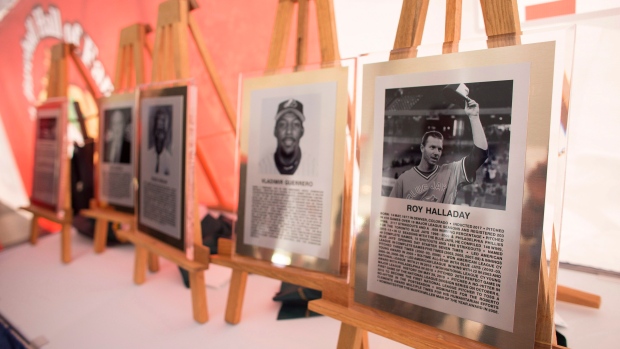Jun 25, 2017
Doc, Vladdy channeled adversity into greatness
Roy Halladay and Vladimir Guerrero are proof the journey into baseball lore doesn’t happen without adversity. The pair were inducted into the Canadian Baseball Hall of Fame in St. Marys, Ontario on Saturday. TSN Blue Jays Reporter Scott Mitchell has more.

Roy Halladay and Vladimir Guerrero are proof the journey into baseball lore doesn’t happen without adversity.
For Guerrero, that adversity came early on when the Los Angeles Dodgers weren’t overly interested in the Dominican teenager with eight siblings, a turn of events that eventually allowed the Montreal Expos to swoop in and sign the future nine-time All-Star in 1993.
“He said the Dodgers said he was too fat, too slow, so they told him, ‘Go home,’” Guerrero joked through a translator. “A few weeks later, he came back and tried out with the Expos and the rest is history.”
Now 42, Guerrero’s tale Saturday during the Canadian Baseball Hall of Fame induction ceremony in St. Marys, Ont., came some 700 km away from where he laid the groundwork for this day with parts of eight sensational seasons in Expos colours.
Standing next to him, the other main attraction, 40-year-old Roy Halladay, was a lot closer to his old SkyDome stomping grounds off Lake Ontario.
About a two-hour drive west gets you to the tiny town of 7,265 residents where the museum has sat since 1994.
“Canada and Toronto has really become a second home for me and I absolutely loved the time that I’ve spent here and, really, it feels like that’s where the majority of my career was played,” said Halladay, who was traded to the Philadelphia Phillies prior to the 2010 season, before calling it a career in December of 2013 due to shoulder and back issues. “I went through all the ups and downs and established myself — twice — so it’s a tremendous honour to be recognized by a place that’s so warm in my heart.”
The word “twice” is key.
Halladay encountered his career-defining adversity after he had already arrived in the majors, with Detroit Tigers outfielder Bobby Higginson’s two-out, solo homer in the ninth inning being the only reason the Denver product known as “Doc” didn’t throw a no-hitter in his second career start in 1998.
Then, in 2001, after a couple years of moderate big-league success, Halladay was optioned all the way back to A-ball in order to rebuild his delivery.
By mid-season, Halladay was back in the Blue Jays’ rotation, seeing better results than he ever had.
In 2002, he went 19-7 with a 2.93 ERA.
In 2003, it was 22-7 with a 3.25 mark.
Just like Guerrero, the rest was history and Halladay spent the rest of the decade building his Hall of Fame resume.
Spending the majority of their primes as marquee names in this country, Halladay and Guerrero had their share of individual battles over the years.
Halladay actually fared quite well against Guerrero, a deadly right-handed hitter known for being able to make solid contact on just about any pitch thrown his way, location be damned.
Guerrero finished with 449 career home runs and a .318 batting average, but just one of those longballs came off Halladay’s right arm in 33 at-bats.
“He was amazing to watch,” Halladay said. “As a pitcher, you felt like you couldn’t throw the ball far enough out of the zone for him still not to hit it. It was amazing. You’d bounce balls and he’d hit them. There was a running belief that all you had to do was throw it down the middle, that was the only place he couldn’t hit it. I did not try that and I do not believe that. Watching him in the field, his throwing arm, he was just an amazing athlete. He was one of those players, when you go to the game, you only watch him.”
Guerrero just missed being enshrined in Cooperstown this year, falling 15 votes short.
That shouldn't happen again in 2018.
Halladay, however, is facing a bit of an uphill battle to join Guerrero in the New York hall, but a case can be made that his run of dominance at least deserves strong consideration when he arrives on the ballot in 2019.

